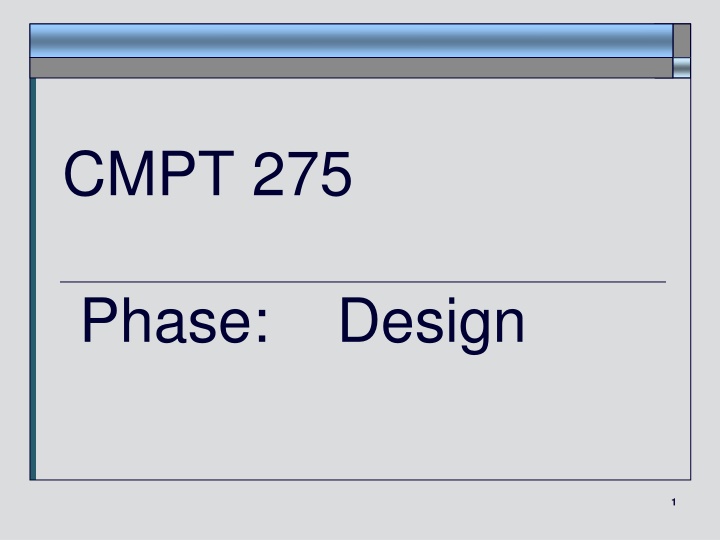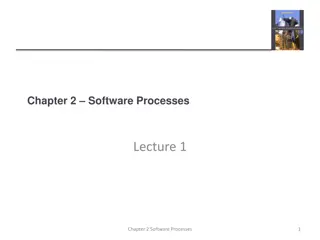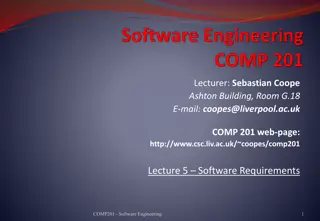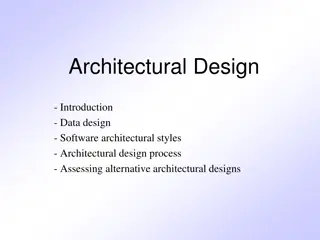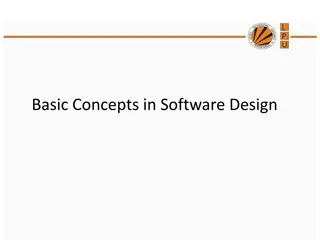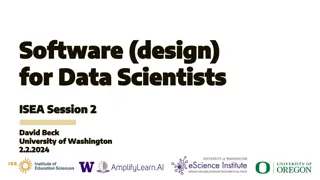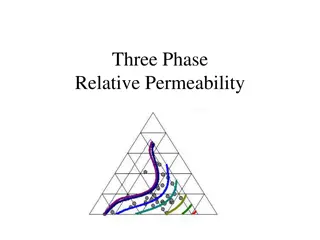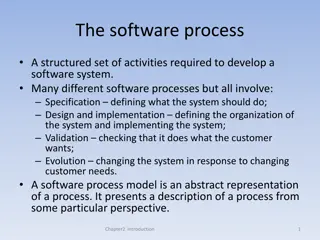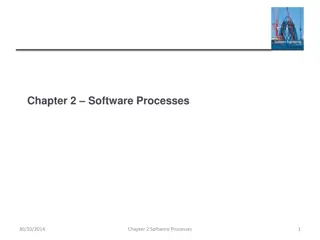Design Phase in Software Development: Overview and Models
This content delves into the design phase of software development, covering low-level and high-level design aspects such as architecture, subsystem definitions, interaction diagrams, and object-oriented design. It emphasizes the importance of refining software representation to serve as a blueprint for implementation and testing. The text also discusses modeling at different phases, including static and dynamic modeling, use cases, scenarios, and class diagrams. Additionally, it explores the significance of interaction diagrams in modeling the dynamic aspects of software systems to achieve specific behaviors.
Download Presentation

Please find below an Image/Link to download the presentation.
The content on the website is provided AS IS for your information and personal use only. It may not be sold, licensed, or shared on other websites without obtaining consent from the author.If you encounter any issues during the download, it is possible that the publisher has removed the file from their server.
You are allowed to download the files provided on this website for personal or commercial use, subject to the condition that they are used lawfully. All files are the property of their respective owners.
The content on the website is provided AS IS for your information and personal use only. It may not be sold, licensed, or shared on other websites without obtaining consent from the author.
E N D
Presentation Transcript
CMPT 275 Phase: Design 1
Map of design phase DESIGN Class Design Product or system Design LOW LEVEL DESIGN HIGH LEVEL DESIGN Data Persistance Subsystem Classes Module Interfaces Class Interfaces Interaction Diagrams Modularization architecture User Interface User Manual Implementation Janice Regan, 2008 2
Map of design phase DESIGN LOW LEVEL DESIGN HIGH LEVEL DESIGN Data Persistant Subsystem Classes Module Interfaces Interaction Diagrams Class Interfaces Modularization architecture User Interface User Manual Implementation Janice Regan, 2008 3
Design phase High level design (product or system design) Architecture Definition of subsystems Description of interaction of subsystems Low level design (design of classes/objects) Attributes Data structures Methods Algorithms Janice Regan, 2008 4
Sub-Phase Low Level Design Sequence Diagrams 5
Low Level Design Objective of Low Level Design Refine representation (models) of software system to a level of detail that will allow resulting representation to be used as a blueprint for implementation and unit test planning phases Janice Regan, 2008 6
Modeling at different phases Static Dynamic 2. Informal Scenarios 4. Use cases 5. Use cases Diagrams 6. Scenarios 1. System Context Diagram 3. Class Diagram Requirements analysis 8. Analyze data persistence 7. Architecture (from 1,4,5,6) High Level Design 9. Refined use cases (from 4,7, 8) 12. Refined use cases and scenarios (from 9) 11. Refined Class Diagram including attributes and methods (from 3, 12, 13) Low Level Design 13. Sequence Diagrams and collaboration diagrams (from 12) Janice Regan, 2008 7
Interaction Diagrams Model dynamic aspects of the software system by specifying the interaction among objects to produce a particular behaviour For each use case Show object interaction Show how software system realizes a use case Help identify object operations (methods) Janice Regan, 2008 8
Interaction Diagrams Two types of interaction diagrams are defined in UML Collaboration diagram: emphasizes the structural organization of objects that send and receive messages Sequence diagram: emphasizes the time ordering of the messages passed between objects However, both diagrams are not computationally complete; they are not algorithms! -> They do not define the behaviour Janice Regan, 2008 9
Sequence Diagram: Format - 1 Initiating actor at top left 1. followed by boxes representing objects 2. initiating actor or or object : Class : Class Module Name Synchronous Message (wait for reply then continue) Asynchronous Message (continue without waiting for reply) Implicit return at end of activation 3. 4. 5. Janice Regan, 2008 10
UML Notational Elements of Interaction Diagrams Note: An object is distinguished from a class in UML notation by the colon An object name is optional Multiple objects of same class may participate in behaviour A link between 2 objects implies an association between their classes in Class Diagram Janice Regan, 2008 11
Sequence Diagram: Format - 2 6. Life line indicating when object is available object : Class 7. Activation box indicates when object is active (receiving messages, doing some activity (although the diagram may not specify this), sending messages object : Class Janice Regan, 2008 12
Sequence Diagram: Format - 3 8. Labels on leftmost part of diagram Indicate actions such as other use cases being initiated Actor Name actor interacting with the UI Identify use case executed These actions are not expressed by an arrow in the diagram since they do not represent inter- module communication Profile altered Janice Regan, 2008 13
Representing messages returnvalue1 = message1(parameter1) Synchronous Message (wait for reply then continue), reply implicit, will return returnvalue1 at end of activation box started by the message, not shown in diagram message1(parameter1) message1(returnvalue1) Synchronous Message (wait for reply then continue), reply explicitly shown, will return returnvalue1 at end of activation box started by the message, return message illustrated Janice Regan, 2008 14
Messages and returns object1 : Class1 object2 : Class2 returnvalue1 = message1(parameter1) message2(parameter2) returnvalue3 = message3(parameter3) message2(returnvalue2) Message can be an actual message or it may be an invocation of the methods of the destination class Janice Regan, 2008 15
Sending messages conditionally object1 : Class1 object2 : Class2 [parameter1 > 23] returnvalue1 = message1(parameter1) Message is sent only if the condition in the square brackets is true. For this example the condition in the square brackets requires the value of parameter1 > 23 Janice Regan, 2008 16
Sending messages repeatedly object1 : Class1 object2 : Class2 * [parameter1 > 23] returnvalue1 = message1(parameter1) Message is sent if the condition in the square brackets is true, the message is sent repeatedly until the condition in the square brackets becomes false. Usually used to send the same message to many objects Janice Regan, 2008 17
Reflexive message object1 : Class1 When an object sends a message to itself, this message is a reflexive message. Janice Regan, 2008 18
Sequence Diagram: Format - 3 7. Creation <<create>> object : Class 8. Destruction object : Class object : Class <<destroy>> Janice Regan, 2008 19
Create and destroy object1 : Class1 <<create>> object2 : Class2 Returnvalue1 = message1(parameter1) <<create>> object3 : Class3 Returnvalue2 = message2(parameter2) <<destroy>> Janice Regan, 2008 20
Sequence Diagram: Format - 4 9. Algorithm details on left most part of diagram Actor Name Algorithm 10. Scenario, Use Case name and functional requirement # Janice Regan, 2008 21
Sequence Diagram: How to! Objects that exist initially are lined up along the top of the diagram beside the actor When object is created later, its box appears further down, at the time when it is created Actor initiates interaction via GUI this is the first message sent Reception of a message by an object causes one of its methods to be executed. Janice Regan, 2008 22
Refined Scenario #1 Use Case Name:CheckInResource (#7) Scenario:StudentPatron Paul returns a book on time. Preconditions: Librarian Eva has successfully gained access to the LMS. LMS is ready to go (DB has been populated, network is up, and LMS has been initialized). LMS screen with Check menu is displayed. Janice Regan, 2008 23
Refined Scenario #1 Main flow of events: 1. Student Patron Paul comes up to the librarian counter to return the Quantum Physics book he borrowed last week. 2. Eva the Librarian choosesCheckInResource option from the LMS screen by selecting the In command option under the Check menu. 3. A window representing a Check In Form is then displayed. Janice Regan, 2008 24
Refined Scenario #1 Main flow of events (cont): 4. Eva takes the book Paul is handing to her and types in its Dewey call number in the appropriate text field then presses the "Accept" button to commit the entry. 5. The Dewey call number for the book was entered successfully and it was a valid call number, information about the Quantum Physics book and the borrowing patron is retrieved from the Database and displayed on the Check In screen. Janice Regan, 2008 25
Refined Scenario #1 Main flow of events (cont): Since Student Patron Paul is returning the Quantum Physics book before its due date, there is no overdue charge. Also, no one is currently requesting the Quantum Physics book. LMS completes the check-in process by changing the status of the book to reshelve , canceling its due date and date of loan , updating its date of return to today, Clearing the borrowing patron ID, removing the Quantum Physics book from the Student Patron Paul s list of borrowed resources. Janice Regan, 2008 26
Refined Scenario #1 Main flow of events (cont): LMS updates the records for the Quantum Physics book and the borrowing Student Patron Paul in the Database. LMS updates the screen showing the newly checked-in book along with the updated dates. Eva verifies by looking at the screen that the book has been checked in properly, then presses the Done button. Janice Regan, 2008 27
Refined Scenarios #1 Postconditions: Student Patron Paul s record is now showing that he is no longer borrowing the Quantum Physics book. The Quantum Physics book has now a status of reshelve , today's date as a date of return , date of loan has been cleared and so has the due date . Janice Regan, 2008 28
Sequence Diagram - 0 Librarian db : LibraryDB : LibrarySystem : GUI Select (checkInPage ) Display (checkInPage ) checkIn ( Dewey call # ) checkIn ( Dewey call # ) QPBook := getResource( call # ) QPBook := create( book, db ) QPBook : Book patronId := getBorrowingPatronId( ) paul := getPatron( patronId ) paul := create ( student, db ) Paul : Student name := getName( ) expiryDate := getExpiryDate( ) title := getTitle( ) author := getAuthor( ) loanDate := getLoanDate( ) dueDate := getDueDate( ) status := getStatus( ) Janice Regan, 2008 29
Sequence Diagram - 1 db : LibraryDB : LibrarySystem Librarian checkIn( Dewey call # ) QPBook := getResource( call # ) QPBook := create( book, db ) QPBook : Book patronId := getBorrowingPatronId( ) paul := getPatron( patronId ) paul := create ( student, db ) Paul : Student name := getName( ) expiryDate := getExpiryDate( ) title := getTitle( ) author := getAuthor( ) loanDate := getLoanDate( ) dueDate := getDueDate( ) status := getStatus( ) Janice Regan, 2008 30
Sequence Diagram 2 A Librarian db : LibraryDB : LibrarySystem Paul : Student QPBook : Book ok := checkIn( date ) Set status = reshelve Set loan date = 0 Set due date = 0 Set return date = today (date) Set borrowing patron id = 0 ok := update( QPBook ) checkIn( call # ) Remove QPBook from list of borrowed resources update( paul ) update( ok ) checkIn (ok ) display( checkInPage ) Press done confirm Display(startpage) Janice Regan, 2008 31
Consider other scenarios What if librarian Eva decides not to press done and confirm the check in of the book but chooses to press cancel and terminate the interaction instead. Look at sequence diagram 2A, what needs to change for this new scenario? Pressing cancel implies that nothing in the database will be changed. If cancel were pressed rather than done we would have to undo the changes to the database. Janice Regan, 2008 32
Consider other scenarios What if librarian Eva decides not to press done and confirm the check in of the book but chooses to press cancel and terminate the interaction instead. If cancel were pressed rather than done we would have to undo the changes to the database. This is clearly extra work, want to ask if done before the database is updated, then only update if done is pressed. Need to refine the use case and the interaction diagram to handle both scenarios Janice Regan, 2008 33
Refined Scenario #1 Main flow of events: Since Student Patron Paul is returning the Quantum Physics book before its due date, there is no overdue charge. Also, no one is currently requesting the Quantum Physics book. LMS completes the check-in process by changing the status of the book to reshelve , canceling its due date and date of loan , updating its date of return to today, Clearing the borrowing patron ID, removing the Quantum Physics book from the Student Patron Paul s list of borrowed resources. Janice Regan, 2008 34
Refined Scenario #1 LMS updates its internal records for the Quantum Physics book and the borrowing Student Patron Paul. LMS updates the screen showing the newly checked-in book along with the updated dates (from its internal records). Eva verifies by looking at the screen that the book has been checked in properly, then presses the Done button. The changes to the records for the Quantum Physics book and the borrowing Student Patron Paul are updated in the database. Janice Regan, 2008 35
Updated Sequence Diagram 2 A Librarian db : LibraryDB : LibrarySystem Paul : Student QPBook : Book display( checkInPage ) verify( flag ) Press done or cancel [flag = done] ok := checkIn( date ) Set status = reshelve Set loan date = 0 Set due date = 0 Set return date = today (date) Set borrowing patron id = 0 ok := update( QPBook ) [flag = done] checkIn( call # ) Remove QPBook from list of borrowed resources update( paul ) checkIn (ok ) update( ok ) Display(startpage) Janice Regan, 2008 36
Sequence Diagram 2 B Librarian db : LibraryDB : LibrarySystem Paul : Student QPBook : Book display( checkInPage ) verify( flag ) Press done or cancel [flag = done] ok := checkIn( date ) Set status = reshelve Set loan date = 0 Set due date = 0 Set return date = today (date) Set borrowing patron id = 0 ok := checkIn( call # ) Remove QPBook from list of borrowed resources ok := update( paul ) ok := update( QPBook ) Display(startpage) Janice Regan, 2008 37
Sequence Diagram 2 C Librarian db : LibraryDB : LibrarySystem Paul : Student QPBook : Book ok := checkIn( date ) Set status = reshelve Set loan date = 0 Set due date = 0 Set return date = today (date) Set borrowing patron id = 0 ok := checkIn( call # ) Remove QPBook from list of borrowed resources display( checkInPage ) Press done or cancel verify( flag ) ok := update( QPBook ) Display(startpage) ok := update( paul ) Janice Regan, 2008 38
Inter-Subsystem Interface Description Goal: To illustrate dynamic relationships between subsystems, and to begin to define what the interfaces of each must be Help us understand what functionality must reside in which subsystem Will eventually allow subsystems to be implemented separately and in parallel Janice Regan, 2008 39
Inter-Subsystem Interface Description Describe interactions Between software system and human users Between subsystems of the software system Between distributed processes (encompassed in a subsystem) over a network Between software system and solutions for data persistence (e.g. database management systems) Can be seen as public interface of module Janice Regan, 2008 40
Modelling Inter-Subsystem Interaction Interaction diagrams (Sequence, Collaboration) Model dynamic aspects of the software system Specify interaction among entities Can be refined during low level design Sequence Diagram: Emphasizes time ordering of interactions Collaboration Diagram Emphasizes structural organization of the objects that are interacting. Janice Regan, 2008 41
Sequence Diagram 1 sequence diagram per use case Specify specialized communication protocol such as Common Gateway Interface (CGI) protocol Hypertext Transport Protocol (HTTP) Janice Regan, 2008 42
System Context Diagram Web Server Application USER Database Janice Regan, 2008 43
Architecture Database interface Here the database is available to the Application. In this representation the Database is not part of the application but an external software product being used by the application Janice Regan, 2008 44
Use case for Web application Use case name: Edit Profile(functional requirement #3) Initiating actor: User Preconditions: DB populated, system running, User reached Web site. Main flow of events: The User requests to edit her/his profile by pressing the Edit Profile button on the Web page. The User validly identifies her/himself to the system through the Identify use case. (identify will shown as an <<include>> in use case diagram) The User s profileis retrieved from the Database and is displayed on the web page. The User updates her/his profile information. (specify information) Janice Regan, 2008 45 .
Use case for Web application The User indicates that s/he is done by pressing the Commit button. The system stores the updated information to the Database and the use case terminates. Postconditions: User record is updated in the Database. Exceptional flow of events #1: (sample of exceptional flows) The User cancels the use case at any point prior to indicating that they have completed the editing by pressing the cancel button. The Database is not altered. Janice Regan, 2008 46 .
Be careful with preconditions! This previous use case specifies that the user has reached the web site. It does not specify that the user has been validated by the security system. The use case indicates that the user will be able to validate their identity after choosing to update their profile (using an <<include>>) The first UI screen on the website will show update profile as a choice. The screen resulting from that choice will contain the validate identity button. Janice Regan, 2008 47
Be careful with preconditions! If the use case specified that the user must have already validated themselves then The first UI screen would be validation (e.g. login), and validation would be a separate use case and sequence diagram used only at login. The second (or later) UI screen would allow the user to choose the option of updating their profile. BE SURE TO BE CONSISTENT IN YOUR DESIGN Janice Regan, 2008 48
